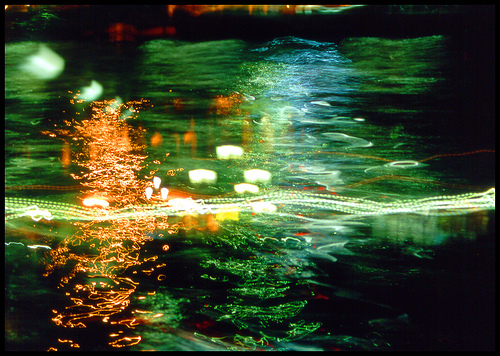 The second I close the hatch behind me, it occurs to me that I have watched far too many horror movies for this to end well. I’m in the basement of a building in South London where people shell out £45 to spend an hour in a sensory deprivation tank. The shiny white pod is about the size of a SmartCar, and its rounded edges remind me a bit of the futuristic, streamlined vehicles in Minority Report. Inside, the total-immersion bathtub is flooded with an unearthly blue light and a quietly swishing mass of water that’s been doped with enough magnesium salts to let me float handily on top, just a bit more than what’s in the Dead Sea.
The second I close the hatch behind me, it occurs to me that I have watched far too many horror movies for this to end well. I’m in the basement of a building in South London where people shell out £45 to spend an hour in a sensory deprivation tank. The shiny white pod is about the size of a SmartCar, and its rounded edges remind me a bit of the futuristic, streamlined vehicles in Minority Report. Inside, the total-immersion bathtub is flooded with an unearthly blue light and a quietly swishing mass of water that’s been doped with enough magnesium salts to let me float handily on top, just a bit more than what’s in the Dead Sea.
There’s also a light switch, an intercom and a spray bottle of freshwater. I find out soon enough why that spray bottle is there. It takes me only about five seconds to get the super-saline water in my eyes, and the stinging is as horrible as it was predictable. I spend the first few minutes alternating between accidentally rubbing my eyes and frantic spritzing. So much for sensory deprivation.
But even after I figure out how to stop injuring myself, I can’t surrender to feeling nothing. Each time I turn off the light and succumb to the pitch black, a tentacled monster emerges from a far corner of my Hollywood-sullied imagination and I immediately need to flip the switch to convince myself that I’m not about to die an ignominious death worthy of another Final Destination sequel. I don’t know what all this says about my psyche, but I do know, as I reach for the light for the 15th time, that I have a very long hour ahead of me.
It also gives me a glimpse into why Amnesty International counts sensory deprivation along with waterboarding as part of the “enhanced interrogation” torture package. Researchers have shown that forcible sensory deprivation can lead to hallucinatory states approaching psychosis. (Word of caution: follow the google breadcrumb trail on this topic, and there’s a good chance you’ll fall down the conspiracy theory rabbit hole.)
 Given all the rumors of links back to military funding, the roots of sensory deprivation are surprisingly benign. In the mid-1950s, John C. Lilly, a psychoanalyst at the National Institute of Mental Health, wanted to investigate what happens to the brain when you experience nothing. Does it run only as a consequence of the constant flood of sensory stimuli the body is subjected to? He wanted to find out whether, in the absence of all sensory input, the brain simply goes to sleep.
Given all the rumors of links back to military funding, the roots of sensory deprivation are surprisingly benign. In the mid-1950s, John C. Lilly, a psychoanalyst at the National Institute of Mental Health, wanted to investigate what happens to the brain when you experience nothing. Does it run only as a consequence of the constant flood of sensory stimuli the body is subjected to? He wanted to find out whether, in the absence of all sensory input, the brain simply goes to sleep.
So he rigged up a soundproof tank in which it’s pitch dark, and in which both the water and air are heated to body-temperature. The salt water removes the sensation of gravity and the temperature is meant to erase the perceived boundary between you and not-you.
So what happens when you experience nothing? It quickly became apparent that the brain doesn’t go to sleep. Quite the opposite. In forced, extended sensory deprivation, you’re going to freak out, much the way I might have if I hadn’t given that light switch the workout of its life. Some people report that they enter a state akin to lucid dreaming. Others find that they are just incredibly relaxed. Intriguingly, some people claim that floating in a sensory deprivation tank puts them into a meditative state. In fact, they say it’s a shortcut.
That would be great news. Meditation, after all, is a huge pain in the ass. It takes a lot of practice to turn an ADD failathon into any semblance of zen mindfulness. The number one obstacle for novices? The sensory distractions. Sitting in even the most comfortable pose will eventually cause some part of you to cramp up. Things will begin to itch. Are you sure you don’t have to pee? Does your neck always feel this tight? And what the hell is all that clanging? Also? Your foot just fell asleep. Have fun “mindfully breathing” your way through the next ten minutes of agony.
Take away every single sensory irritant and distraction, and it makes perfect sense that your brain would slip right into the meditative state. So sensory deprivation is like meditation for cheaters!
Because meditation has been shown in study after study to have such clear benefits, and yet is so frustrating for novices to get into, researchers are starting to investigate the link. Tamara Russell, a clinical researcher in psychological medicine at King’s College London, has been doing some small studies into the similarities between experienced floaters and lay meditators. She’s found some indicators that people who lie in a float tank on a regular basis showed some similar improvements on mindfulness tasks as experienced meditators.
But that’s as far as we’ve gotten. Because while we have a decent idea of what takes place during meditation, there hasn’t been much other research on what happens in the brain during sensory deprivation. It’s proved a little tough to do neuroimaging studies on someone floating in a giant bathtub of salt water. Even if you could rig up a waterproof apparatus, having electrodes sticking and tugging at your skin and hair can’t help interfere with a carefully controlled environment whose entire aim is to eradicate any reminder that you have a body.
So it sounds right, and it’s tempting. But actually, the truth is surprising and totally counterintuitive: sensory deprivation can actually be an impediment to achieving a true meditative state.
During meditation, you constantly have to pull your attention back to thinking about nothing—yanking the leash on your distracted mind—and that constant “flexing” is akin to strengthening a muscle, Russell explains. “Working through the mind’s reaction to pain and discomfort is a huge part of the process,” she says. “That’s how you learn how your mind reacts to aversive experiences.” And the more you do it, the better you get at reining in your mind from all those distractions. The bad news? It can take tens of thousands of hours in this hellish mind gym to become any good at meditating.
But let me tell you: even if it’s not meditation, what happens instead is no joke. Once I calm down about the tentacle monsters, I begin to dip into brief pockets of the kind of deep trance that feels like being awake and dreaming. In sensory deprivation, memories are stunningly, viscerally real. I’m reminded of scenes in films like the Matrix, in which the action is paused while the camera pans dizzingly around the scene to reveal ten new perspectives. I can perform the same manipulation on my memories. It’s like lucid dreaming; your daydreams made real and under your control. I’m absolutely delighted by this realization—and just as with real dreams, as soon I become aware of that delight, I’m immediately, disappointingly snapped back into awareness and back into that silent, black space full of salt water.
That state I fell into for a few brief moments can be extended the more practice a person has, and these tiny bursts of hypnotic, hallucinatory dream state are the same thing as what’s experienced by people who have been meditating for a long time.
And then what happens? “People have said that they’ve gotten out of the tank after one session and have realized that they’re never going back to that job,” says Tim Strudwick. Of course he’d say that—he’s been running the place for 18 years, so he has a stake in its benefits. But he was as skeptical as I was when he first found himself floating in a tank in Notting Hill surrounded by what he refers to as “people in flowing kaftans.” He was there as a last ditch attempt to fix a nasty back injury that had resisted all ministrations from physical therapy and similar specialists. It worked. Within a few weeks of his first float, he was exercising again and his back stopped hurting him. He never looked back.
Strudwick tells me that a US Navy SEALs team based in North Carolina have just bought four sensory deprivation tanks to aid post-operative recovery, and that the army doctors hope to investigate the effects on soldiers dealing with post-traumatic stress disorder.
The entire country of Sweden seems to agree that floatation tanks are worth investing in. That tiny country has something like 120 float centers, a ridiculously high number for a country whose entire population could comfortably live in New York City. So, interest in sensory deprivation is rising, and researchers are starting to look into whether anecdotal claims about its benefits can be backed up.
Funny enough, one of the biggest problems that confounds research on floatation versus meditation is that it’s really tough to find a pure sample. To properly compare “floaters” with meditators, ideally you’d want a group of floaters who haven’t done any meditation. And there’s the rub: As you might expect, people who are motivated to lie in a pitch dark pod and pickle themselves for an hour have already had some prior experience with meditation or yoga.
image credits:
Main image: flickr/Lorenzo Maddalena/lo.re.n.zo
Altered States film poster: Dreaming Life
It sounds like a ghastly place to find yourself in. How did you last an hour??
Only the first half hour was tough. After that, it was amazing. I went back a second time, too!
Did you do any tests to see if it lowered your blood pressure or anything?
Letting go is hard to do and takes practice…. your concious mind likes to stay in control and often will create stuff to stop you, it’s why people trying to meditate experience phantom itches and pain.
Once you learn how to let go the floatation environment will show you infinite layers of vivid memories, free association, sudden insights, creative inspiration and feelings of serenity and oneness with the universe.
Sally, come to me in my caves, and you can have all the sensory deprivation you want. No kidding.